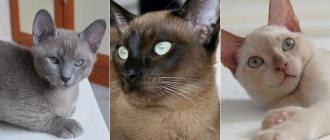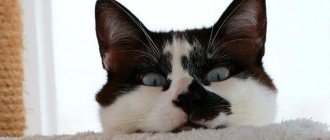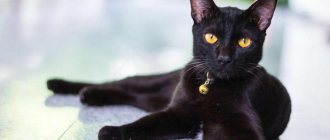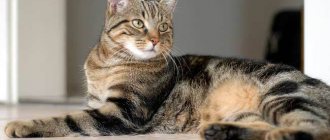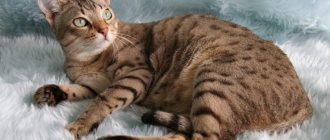The Somali cat is an amazingly beautiful creature. In 1967, Evilyn Megue, an American breeder of Abyssinian cats, took into her home a cat that had already been abandoned by about five owners within a short time. The incredible beauty of the resulting Somali breed shocked Evilin. She decided at all costs to find out at least something about his origin.
- 4.1 Care
Brief history of the breed
The homeland of Somali cats is the United States, and they owe their appearance to American breeders. In the 40s of the last century, some breeders involved in breeding Abyssinians began to have kittens with long hair. Since they did not meet the generally accepted standard, they were considered a “manufacturing defect” and were distributed free of charge to friends.
This could have continued indefinitely if, in the late 1960s, long-haired Abyssinians had not attracted the interest of the owner of an American kennel, Evelyn Matthew. The woman named the unusual cats Somali and became the founder of the first society of lovers of this breed.
In parallel with her, the Canadian breeder Mary Mayling was promoting non-standard Abyssinians. She demonstrated long-haired beauties at exhibitions, helping to popularize them.
As a result, through joint efforts, the breeders were able to resist the resistance of Abyssinian nurseries that were actively fighting with competitors. Their actions led to Somalia being officially registered in the United States in 1978. And in 1982, the breed received recognition from the International Cat Federation.
Nuances of breeding
Breeding Somali cats involves a number of difficulties. Representatives of this breed mature early - often at 4-6 months, when it is too early to think about mating. As a result, an owner planning to get kittens will have to endure urine marks and loud “songs” for several months.
Since hereditary pathologies are quite common in Somalia, in order to give birth to healthy kittens, the partner for mating should be selected very carefully.
A stud cat often requires a separate room where he will receive ladies and can mark corners to his heart's content (keeping fertile temperamental Somali cats is extremely rarely complete without marks).
If you do not like such tests, it is better to castrate the cat, and sterilize the female cat. This will not change their character at all, but the content will become much more comfortable. Even an animal deprived of the opportunity to reproduce can make an exhibition career - in the castrati class. Experts at shows usually treat such pets very well.
Somalis are very active cats; a good solution would be to organize a separate play area for them.
Interesting Facts
Over the years of the breed’s existence, many interesting things have been associated with it:
- For its fluffy tail and fiery fur, the Somali cat received the nickname “domestic fox.”
- Representatives of the breed love to play with water. Somalia likes to catch splashes with its paws. In addition, they can independently open the taps and look at the dripping water for a long time.
- The name of the breed was not chosen by chance. Due to the fact that the ancestors of these animals were Abyssinian cats, it was decided to name them Somali in honor of the country that neighbors Abyssinia on the map (now Ethiopia).
What owners say about the Somali cat
If you have a Somali cat in your home, you probably read reviews about it on the Internet in advance. But just when you are planning to get a Somali, you can still look for available information. We would like to present to your attention a review left on our website by the real owner.
Egor, 25 years old.
It is not for nothing that Somalis are described as very active animals. These are real fidgets. At least my cat Franklin confirms this: in the 3 years of living in my apartment, I have never noticed him sitting idle, unless he was sleeping, of course.
Looking at his cute face, you would never think that he is capable of scratching, biting and generally rebelling in some way. But this is a misleading impression.
This Somali cat, like a pirate from his homeland, is constantly looking for some adventure. And the more dangerous they are, the happier his cunning face is. He constantly, literally “meows” my attention - if he’s in the mood to play, he won’t leave until he gets tired of it, and it doesn’t matter whether I want to communicate with him or not.
He always needs to climb somewhere, observe something, study everything that catches his eye.
Franklin will not miss an opportunity to play pranks and mischief, for example, he can steal some small necessary thing right from under my nose, as soon as I gape, dump it on the floor, and even hide it somewhere under the sofa. Sometimes I really want to rip him by the scruff of the neck... But it’s a pity. And without these tricks of his it would have been even boring.
I advise everyone who does not need a bland, monotonous life alone with a constantly snoring cat to buy a Somali - life will be fun, with a sparkle))
Breed description, standards, appearance
Somali cats are fluffy animals with a stretched, flexible body and a long tail. Outwardly, they are very similar to representatives of the Abyssinian breed, but they have their own standard and several fundamental differences.
Dimensions and weight
Representatives of the Somali cat breed are not heavyweights. But due to the fact that they have developed sexual dimorphism, females look lighter and smaller than males. The average weight of a Somali cat is 2.5-4 kg. The weight of an adult cat can reach 4-5 kg.
Anatomical characteristics
A typical Somali cat should fit the following description:
- The head is wedge-shaped, with rounded lines, a smoothly contoured profile and a strong chin.
- The eyes are large, wide-set, almond-shaped. The iris color can vary from amber to green. Silver Somalis prefer green eyes.
- The ears are large, set far apart, with a wide base and slightly rounded tips.
- The body is flexible, long, with developed muscles, a slender neck and a slightly protruding chest.
- The limbs are slender, tall, with small oval paws.
- The tail is long, thick at the base, gradually tapering to the tip. Fluffy fur grows thickly on it.
Color and coat type
Somali cats are covered with a smooth, thick coat, under which lies a thin but dense down. There is less hair on the back and shoulder blades of this breed than on the belly. The Somali has a luxurious “collar” on its neck, and “pants” on its hind legs.
On a note. According to the standard, the Somali cat can have whiskers. And in the interdigital space the presence of tufts of wool is allowed.
The main distinguishing feature of the Somali cat is the presence of ticking. Each hair of an animal must have dark transverse stripes, and the more of them, the more valuable the individual is considered. According to the standard, Somali cats can have the following colors:
- Wild – brown-red or slightly reddish coat with black ticking. On the back of the Somali there is a dark line called the "dorsal strap".
- Sorrel is a coppery-red coat with red-brown ticking. The bases of the Somali hairs are apricot-colored. The tips of the ears and tail are brown, the paw pads and nose are pink.
- Fawn - matte beige coat with dark cream ticking. The bases of the hairs are colored light cream.
- Blue – gray-blue wool with steel ticking. The bases of the Somali cat's hairs are cream or light beige. Paw pads are gray with a blue tint.
On a note. Somali cats are allowed to have “silvered” colors. They are a combination of light base and ticking.
Possible breed defects
Flaws in appearance, in the presence of which a cat of the Somali breed will not receive the highest expert rating:
- short tail;
- rough build;
- heavy head;
- no ticking;
- cryptorchidism;
- gray undercoat;
- polydactyly;
- blurry shade of fur.
Color
Ticked color is the main characteristic of the Somali breed. Ticking is transverse dark stripes on each hair, separating several color colors.
The more stripes, the more valuable the animal. A Somali cattery is considered reputable if the animals are heavily ticked and do not deviate from the established color rules.
The palette of colors of Somali cats, as in the case of cats of the Kurilian Bobtail breed, becomes more and more refined every year. But initially only “wild” and “sorrel” existed.
Somali cat of roe deer color
Today the main range consists of:
- Wild (ruddy) . The cat's reddish or brownish-red fur has black tips. A so-called dark back strap is required.
- Roe deer (fawn). The main color is matte cream, with warm dark shades in the zones. At the base the coat is very light. In fawn cats, uniformity of color is valued above all else.
- Blue The coat is smoky blue on the surface and light beige or light cream at the base. Gray-blue stripes are clearly visible. The paw pads match them.
- Sorrel. The copper-red, sometimes tanning coat has an apricot base. The tip of the tail and the points of the ears are brown. The nose and pads are pink.
The Somali cat can also have “silver” colors. They are obtained because the main color of the coat remains classic, and the undercoat and ticking are white.
Somali cat kittens are very playful and love to play hide and seek and hide in unexpected places.
Character and temperament
Somali cats are endowed with a friendly and playful disposition. Aristocratic and sociable representatives of the breed remain cheerful until old age and extremely rarely show aggression. Curious and active, Somali cats are not the type to snooze quietly on the couch. They explore every corner of the apartment more than once and find something to do with themselves.
Friendly and sociable, Somalis get along well with children and will never let their claws out. The good nature of cats of this breed extends not only to people, but also to other animals. The non-conflict nature of the Somalia helps them easily find a common language with their brothers, non-aggressive dogs, fish, birds and ornamental rodents.
How to choose the right kitten
Somali cats are distributed throughout the globe. Therefore, there are usually no problems with buying such a pet. To protect yourself from possible deception, it is better to purchase a Somali kitten from a certified nursery or from a trusted breeder. At the time of purchase, he must have documents about his origin and vaccinations.
The Somali kitten chosen must meet the breed standard and show no signs of cowardice. It is important that he has clean eyes and ears, a soft belly, fluffy fur and smooth skin without scratching or rashes. A healthy Somali kitten should not have bad breath or dirt under its tail.
Kitten care
Responsible breeders do not wean Somali kittens from their mother before they are 12 weeks old. Therefore, kids move to new homes completely independent. This means that the owners can only give them a little time to get used to the changed conditions and ensure safety.
To prevent the curious Somali kitten from being injured while exploring his property, decorative plants, chemicals, small objects and wires are hidden from him. Also, for security reasons, his access to large household appliances and open windows is blocked.
Somali cat: description and external signs
In addition to the fact that the Somali is very different from other cat breeds due to its thick and long fur, its obvious external signs are also a very long , fluffy tail and small size, due to which it is also commonly called the “domestic fox.”
The main distinguishing features of this breed are:
- average weight, which ranges from three to five kilos;
- the height of an adult animal can reach 30 cm;
- the Somali cat, despite its size, has a very strong, muscular and flexible body with very soft and smooth outlines;
- thanks to the graceful curve in the back, you always get the impression that a cat of this breed is ready to instantly jump at any moment;
- the chest is slightly convex and rounded;
- Somalis have very thin and at the same time slender front and rear legs. The ends of the paws are rounded, and the tips at the bottom of the paws are very graceful and thin. It is noteworthy that a cat of this breed has very noticeable tufts of wool between the pads on its paws, thanks to which the animal always has a graceful and soft gait;
- As for the shape of the head, this breed’s head is wedge-shaped and somewhat resembles a heart. At the same time, it is relatively small and tapers very harmoniously towards the chin;
- The pet's muzzle can be compared to a fox's - it has smooth and soft contours. Moreover, in no case can this breed have a pointed muzzle;
- has a small chin without a clear bite;
- But Somalia's ears are quite large. A distinctive feature is the presence of small tassels at the pointed ends of the ears;
- The animal has a very long and fluffy tail, which is very reminiscent of a fox. Although the tail is actually thin, this cannot be noticed, since it is covered abundantly with hair;
- On the face there are attractive eyes that have a clear outline, which gives the feeling that the cat’s eyes are outlined. As for the color of the pupils, it is usually emerald green, hazel or amber;
- The Somali cat has a very thick and soft coat. Moreover, the denser it is, the better for it.
Care and maintenance
Somali cats easily adapt to different conditions and do not require special care. The owner can only provide basic hygiene, proper feeding and timely veterinary care.
Hygiene procedures
In order for a cat of the Somali breed to look neat, it is provided with proper care:
- The animal's ears are cleaned weekly with a cotton swab soaked in a special lotion. If pus or other unusual discharge is detected, the cat is taken to the veterinarian.
- Somali eyes are wiped daily with a clean cloth moistened with boiled water or chamomile infusion.
- The cat's claws are shortened with a nail clipper as they grow. In order not to cause pain to your pet, you must act very carefully so as not to touch living tissue.
- Somali teeth are brushed 3-4 times a month with a special brush with a small amount of non-foaming paste. This procedure will help remove plaque and prevent stone formation.
Grooming
The Somali cat's coat is not prone to tangles. To ensure that the coat always looks well-groomed, it is regularly combed with a special comb with rare teeth.
Important! It is not recommended to brush Somali cats with plastic combs and brushes with artificial bristles, as they have a detrimental effect on the condition of the protective layer of the coat.
Representatives of the breed are bathed no more than 3-4 times a year. To do this, use yolk shampoos or products for long-haired breeds and water, the temperature of which does not exceed 40 degrees. A washed Somali cat is dried with a towel and dried with a hairdryer.
Tray
For cat litter, it is advisable to use a convenient, easy-to-clean tray with high sides. The litter is usually selected taking into account the preferences of a particular animal.
Features of care
The Somali cat, like all large long-haired breeds, including the Maine Coon and Norwegian Forest Cat , requires special care.
It's all about the animal's long fur, which should always be lush and beautiful. And for this it is worth keeping an eye on the animal and cleaning its fur on time, especially after walks.
Combing
Thin, soft wool of medium length always lies perfectly, does not get tangled and does not form tangles.
But you shouldn’t neglect combing, because the coat is richly fluffy with undercoat, which needs to be combed out using a furminator for cats .
The Somali cat, when using this device, is not subject to heavy shedding, so cleaning the house will not take much time.
Walk
If a Somali cat lives in an apartment, it requires regular walks. A harness and lawn are an excellent option, but only if the owner is confident that there are no ticks on the lawn.
It is much safer in this regard to have your own plot, well-groomed and sprayed from insects. A budget-friendly, harmless option is a well-fenced balcony.
Thin, soft wool of medium length always lies perfectly, does not get tangled and does not form tangles. But you shouldn’t neglect brushing your Somali cat, because the coat is richly downy with undercoat, which needs to be thinned out.
Nutrition
The Somali cat needs high-quality food. The owner can give preference to ready-made food or prepare fresh food himself.
Both options are good, the main thing is that the prepared food contains at least 40% meat (and this is already an expensive segment) and does not alternate with regular food.
Such a menu is the path to diseases of the digestive system. If the menu is natural, then it is important to observe the proportions: the ratio of animal to plant food for kittens is 3:1, for adults 2:1.
The diet should also include fish oil, eggs, vegetable oil, fermented milk products and special “cat” milk.
The Somali cat will not refuse a delicious lunch
Feeding the cat
Somalis require a balanced diet and most breeders recommend dry feeding them. But cats will not refuse natural food. Therefore, when choosing food, each owner takes into account his own capabilities.
Complete diet
With the industrial type of nutrition, Somalis buy high-quality premium or super-premium food, which does not contain soy, preservatives or dyes. Cats of this breed digest well the following brands:
- Brit Care;
- Pronature;
- Royal Canin;
- Grandorf.
With a natural type of nutrition, Somalis select a diet that consists of 70-80% meat. The cat menu is also supplemented with cereals, non-starchy vegetables, offal, fermented milk, eggs and ocean fish.
It is strictly forbidden to treat Somalis with bones, sweets, pastries, sausages and pork. It is also undesirable to give cats of this breed river fish, onions, whole milk, smoked meats, pickles and any leftovers from the master's table.
Important! In order not to provoke gastrointestinal problems in your cat, it is not advisable to mix natural and industrial food.
Feeding frequency
Somali kittens eat little, but often. Therefore, when drawing up a feeding schedule, the age of the animal must be taken into account:
- up to 3 months – 5-6 times a day;
- 3-5 months – 4 times a day;
- 5-12 months – 3 times a day.
From the age of one year, the Somali cat is fed twice a day.
Vitamins and minerals
In the body of Somali cats that eat natural foods, a deficiency of microelements may occur. To compensate for the lack of nutrients, animals are given vitamin and mineral supplements twice a year. The choice of feeding should be made by a veterinarian, taking into account the characteristics of a particular cat.
On a note. If a Somali eats high-quality dry food, she does not need additional vitamins.
Nutritional features of Somali cats
The diet of Somali cats is formed based on the behavioral characteristics of the breed. Since these animals are very active and restless, foods with a high protein content should predominate in the furry menu.
Somali cats need to be fed in moderation to avoid obesity
Ready-made premium and extra-class food will help achieve balance in the food system of Somali purrs. In addition, this hard food will be a good prevention of gingivitis and tartar.
If the pet is accustomed to eating natural food, then it is necessary to give the cat vitamins with calcium and phosphorus to maintain healthy bones and a shiny coat.
The tailed cat should be fed twice a day and not fed from the table during the day. The breed is omnivorous and has an excellent appetite, which is fraught with obesity and digestive problems. Therefore, the serving should not exceed 120–150 g for an adult animal.
The menu of a bushy-tailed pet should include the following products:
- boiled meat and offal (liver, tongue, kidneys) - every day;
- boiled sea fish - no more than twice a week;
- steamed vegetables (zucchini, beets) - every other day;
- fermented milk products (cottage cheese, fermented baked milk) - two to three times a week;
- chicken or quail eggs - up to two times a week.
It is also useful to pamper your pet with fresh cat grass, which can be purchased at a pet store. In addition to filling the body with vitamins, this product also performs another useful function - it expels swallowed hairballs from the digestive organs.
And for better absorption of natural food, you should give your cat up to two tablespoons per week of vegetable oil and fish oil (two to three teaspoons per week).
It is also advisable to monitor the balance of plant and animal foods in the fluffy’s diet. A kitten up to adolescence (12–13 months) should receive vegetables and meat in a ratio of 1:3, and for adults the volume of vegetables increases to a ratio of 1:2.
Interestingly, to give the Somali cat’s red coat a rich hue, experienced breeders recommend giving the animal more boiled carrots.
It is also important to constantly monitor the availability of drinking resources for the cat, especially if the purr eats ready-made food - dry or canned.
It is forbidden to give a Somali cat food that can cause digestive upset - fried and fatty, smoked and pickled, salty and sweet, flour and milk.
Education and physical activity
Somalis are smart animals with good memory and a high level of intelligence. Representatives of the breed quickly become accustomed to the tray and easily learn the rules of behavior in the house. If desired, Somali cats can be taught basic commands.
Representatives of the breed are endowed with an energetic temperament and remain active even in old age. Therefore, owners need to make sure that the Somali has enough toys and a tall scratching post tree.
On a note. The Somali cat loves to be outside, especially if it is taught to walk on a harness from childhood.
History of the breed
The origin of Somalia comes from Ethiopia, which was once called Abyssinia. It was here that the appearance of the Abyssinian breed was first recorded. As for the question of where the Abyssinian got such long hair, the answer has not yet been found. There are two assumptions: either this is the result of a centuries-old genetic mutation, or it is a consequence of crossing this breed with other varieties of cats .
In any case, the Somali cat breed first became known in 1965, when this breed was officially registered in Canada. The American breeder E. Magyu, as a result of crossing two breeds of Abyssinians - American and Canadian, gave birth to a new species of cat, which [and was nicknamed Somalia. It was only in 1972 that the Somali cat breed was officially recognized by the American Feline Association as a separate and independent cat breed.
Vaccinations and antiparasitic treatment
To prevent infectious and viral diseases, Somalis undergo routine vaccination. At the age of 7-8 weeks, a kitten of this breed is vaccinated against panleukopenia, rhinotracheitis and calcivirosis. After 28 days, he is vaccinated against the same diseases and against rabies. Subsequently, Somalis are vaccinated annually.
To prevent a cat of this breed from becoming infected with diseases carried by fleas and worms, it is regularly treated for external and internal parasites. Somali anthelmintic drugs are given once every six months with mandatory repetition after 10-14 days. The dosage of the medicine is calculated taking into account the weight of the cat.
Somalis are protected from fleas with drops, shampoos and anti-parasitic collars.
Pros and cons of the breed
Like any other breed of cat, the Somali has not only advantages, but also disadvantages.
| pros | Minuses |
| High level of intelligence | Need for space for games |
| Lack of excessive shedding | Tendency to serious illnesses |
| Low maintenance |
Somali cats are attractive animals with aristocratic habits and natural grace. Their mischievous nature and love for children make them real contenders for the right to be called ideal companions for young families in which kids who dream of a furry pet are growing up.
Health and life expectancy
Somali cats boast good health. Average life expectancy is 12-13 years. But there are still several specific diseases. And the first of them is gingivitis (inflammation of the gums), a tendency to form plaque and tartar. Proper nutrition with dry food or high-quality natural products will help avoid this kind of problem.
The second big problem that can befall a Somali cat is autoimmune hemolytic anemia. If the slightest signs of anemia appear, you should immediately take your cat to a veterinarian, who will most likely prescribe steroid therapy as treatment.
And, of course, we should not forget about regular veterinary preventive measures: vaccination, deworming and treatment for external parasites.


